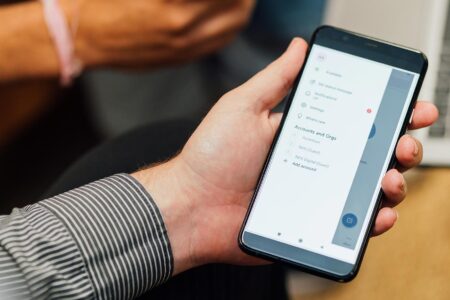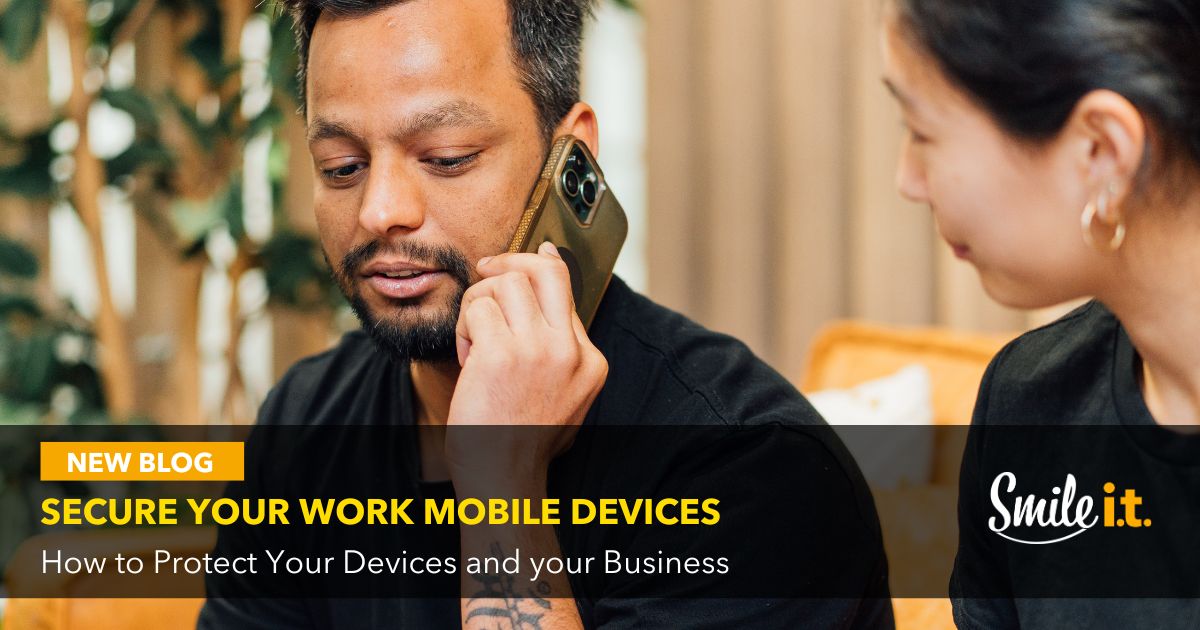Our working world sits in the palm of our hands. No longer are we bound to our desks – we can talk, video conference, email, send invoices, open apps, film marketing movies. All from a handheld mobile device!
It’s surprising then, that mobile device security is often way down on business’s cybersecurity lists. All that convenience comes at a risk – a business mobile phone can become a gateway for cybercriminals that threaten your operations, finances, and reputation. If a single work phone gets compromised, business emails, passwords, financial data, and client information could all be exposed.
This has become a massive concern in Australia, particularly for businesses, where remote work and BYOD policies are getting more commonplace. Securing your and your employees’ devices is essential, so in this guide, Smile IT is going to go through some essential steps you can take to protect your devices and, ultimately, your business.
Why Mobile Device Security Matters

Cybercriminals are evolving as the tech advances, and mobile devices are one of the easiest targets. Small, large businesses, it doesn’t matter. We’re all potential victims of phishing attempts, malware infections, and unauthorised access. Think your company is too small to be a target? there are cyber attacks every 10 minutes, and 43% of the them target small businesses.
If that wasn’t worrying enough, unsecured work devices are usually the entryway into your wider network. Hackers could use a single compromised phone to infiltrate email servers, cloud storage, and even internal databases.
So, protecting your devices means protecting your business. Let’s look at how to do it effectively.
How to Secure Your Work Devices
1. Lock and Encrypt Every Device
This is your first line of defence. Every work phone must be protected by a strong passcode, fingerprint, or, even better, a face ID.
Passcodes like “1234” or “0000” are the first try for hackers or software they’re using. You’ll need a complex, difficult-to-guess passcode.
Turn on encryption for all devices that support it – your phone, laptop, and tablet. Encryption is the process of scrambling data to protect it from unauthorised access. So, even if cybercriminals manage to get hold of your device, the data on it cannot be easily accessed. Most recent iPhones and Android devices already come with encryption enabled by default.
Set phones to lock automatically after a minute of not being used. This way, even if you leave your phone unattended, anyone trying to access it will need to enter the passcode.
- Actionable Tip: Make it a company policy for all phones to require passwords longer than six characters.
2. Keep Software Updated
Postponing software updates can be risky. New updates from the operating system often fix the previous version’s bugs, mostly safety vulnerabilities. If you’re using an outdated operating system, you’re leaving a door wide open for potential breaches.
Sure, updates always seem to happen at the worst time, like when we’re in a rush to finish a task or need to hop onto a video call pronto. Be patient though – it’s better than exposing sensitive data. Most operating systems have an option to update the software automatically. All employee’s should have it turned on.
As well as the OS, make sure that all apps the company is using remains up to date. Outdated programs often have unpatched flaws that can become entry points for cyberattacks.
3. Use Trusted Apps Only
Unverified apps can be trojan horses for mobile malware. Malicious apps can look legitimate and sneak malware onto devices. These can steal data or even take control of the phone.
Every app should be downloaded directly from the App Store or Google Play Store, depending on the device.
Ask yourself these questions before downloading anything:
- Does the app require unnecessary access to things like photos or microphones?
- Is it created by a trusted developer?
- Are there any bad reviews or ratings?
- Is it asking for any payment details?
If the answer is yes, it’s best to avoid downloading the app or research more before you do.
- Actionable Tip: Enable company-wide restrictions for unapproved applications using mobile device management (MDM) software.
4. Be Cautious with Public Wi-Fi Networks
Although it seems handy, especially when travelling, Wi-Fi at airports, cafes, and other public spaces is usually a haven for hackers.
The data you transmit over a public Wi-Fi network is not encrypted and can be intercepted by cybercriminals. Emails, credentials, and confidential documents on your device can be easily stolen. We tend to ignore the warning signs reading ‘unsecured network’, but connecting to such networks can be a huge risk.
If possible, use mobile data on your phone or a secured personal hotspot. If you must use public Wi-Fi, make sure to use a VPN. A VPN encrypts the data being transmitted from your device, so even if it is intercepted, cybercriminals cannot read it.
- Actionable Tip: Disconnect the auto-join feature on your devices for public Wi-Fi networks.
5. Set Up Device Tracking and Remote Wiping
Losing something can be a nightmare, but it happens. What’s worse is losing a device containing sensitive information, especially if it falls into the wrong hands.
Having an exact location for your device at all times can be a lifesaver. Androids and iPhones both have built-in tracking systems, “Find My iPhone” and “Find My Device.” This way, you can always know the location of your device, and hackers can’t turn it off that easily.
If the device is already far away, deleting everything is the only option. Make sure to have the necessary software and passwords ready to wipe the device clean. It’s also important to have a backup of your data stored on the cloud or on a separate device.
- Actionable Tip: Make sure these features are activated during device setup for the work phones. Also, create a protocol for reporting lost devices.
6. Educate Your Team about Phishing and Scams

Although most people can easily spot a phishing email, there’s always a chance that someone in your team might fall for one. Run awareness sessions. Teach employees how to identify suspicious links, emails, and messages.
- Actionable Tip: Implement anti-phishing tools and filters. These can help block common scams from reaching inboxes in the first place.
Other Security Measures
Staying safe online goes beyond just the things we’ve mentioned above. Here are some other things to have in mind:
- Use strong passwords. This may seem obvious, but many still use weak or easily guessable passwords.
- Add Multi-Factor Authentication on all accounts that offer it. 99.9% of breaches happen to accounts without it, according to Microsoft.
- Use MDM systems to manage company devices. Mobile Device Management allows you to remotely manage and secure devices your team uses for work.
- Have secure BYOD policies in place if you allow employees to use personal devices for work.
- Use firewalls and anti-virus software. It’s better to pay for premium protection than to deal with the consequences of a data breach.
- Every employee should know the basics of cyber security. Get a professional to train your team on how to keep their devices and information safe.
Don’t Put Off Mobile Security Until It’s Too Late
The harsh reality is cybersecurity breaches can cost businesses thousands, even millions, of dollars. Lost client trust, regulatory fines, and operational downtime can be devastating.
But, as alarming as these risks are, mitigating them doesn’t need to be complicated or expensive. Smile IT specialises in cybersecurity solutions tailored for Australian businesses. Device management, network security, data protection – we cover it all so you can focus on what’s important. Get in touch with Smile IT today. Your peace of mind is just a call away.
When he’s not writing tech articles or turning IT startups into established and consistent managed service providers, Peter Drummond can be found kitesurfing on the Gold Coast or hanging out with his family!


